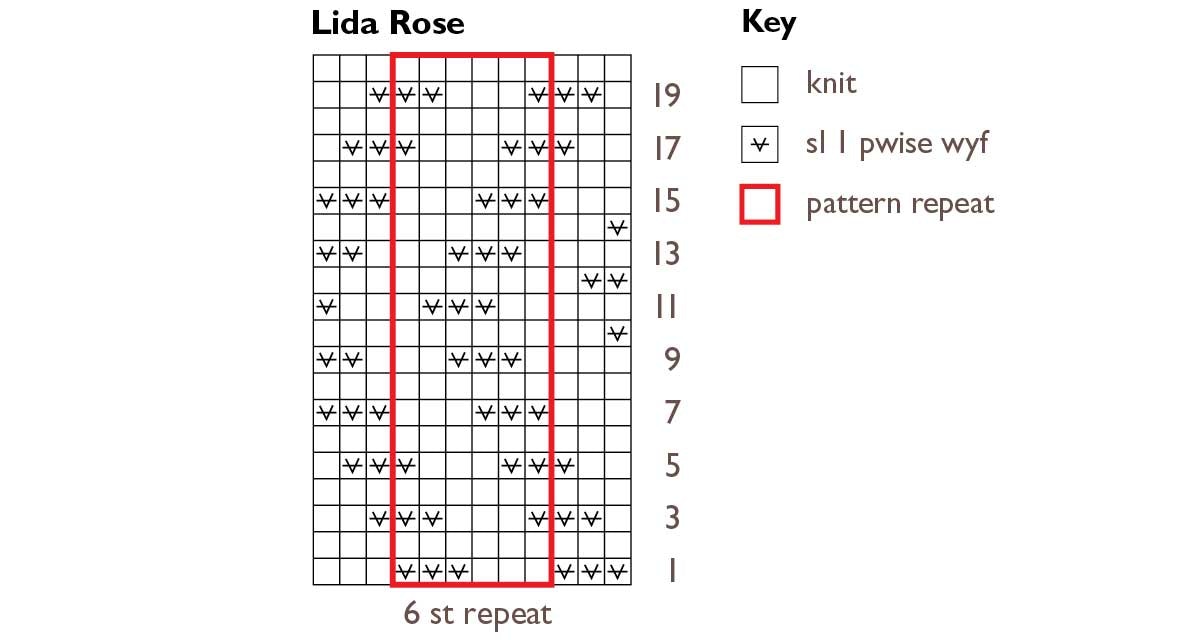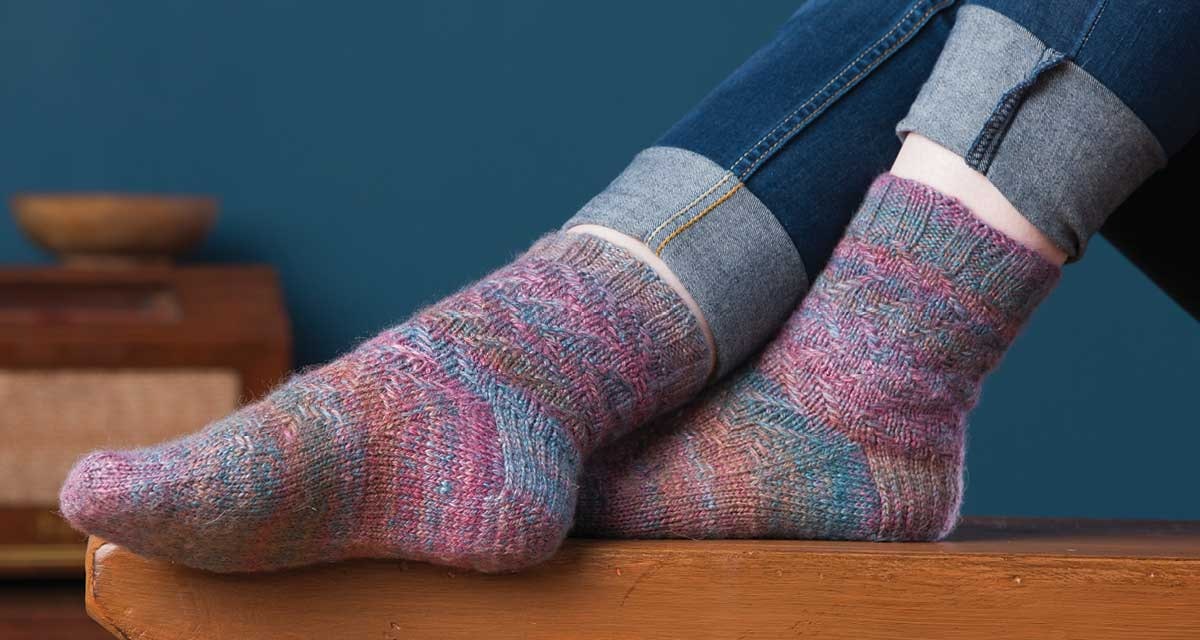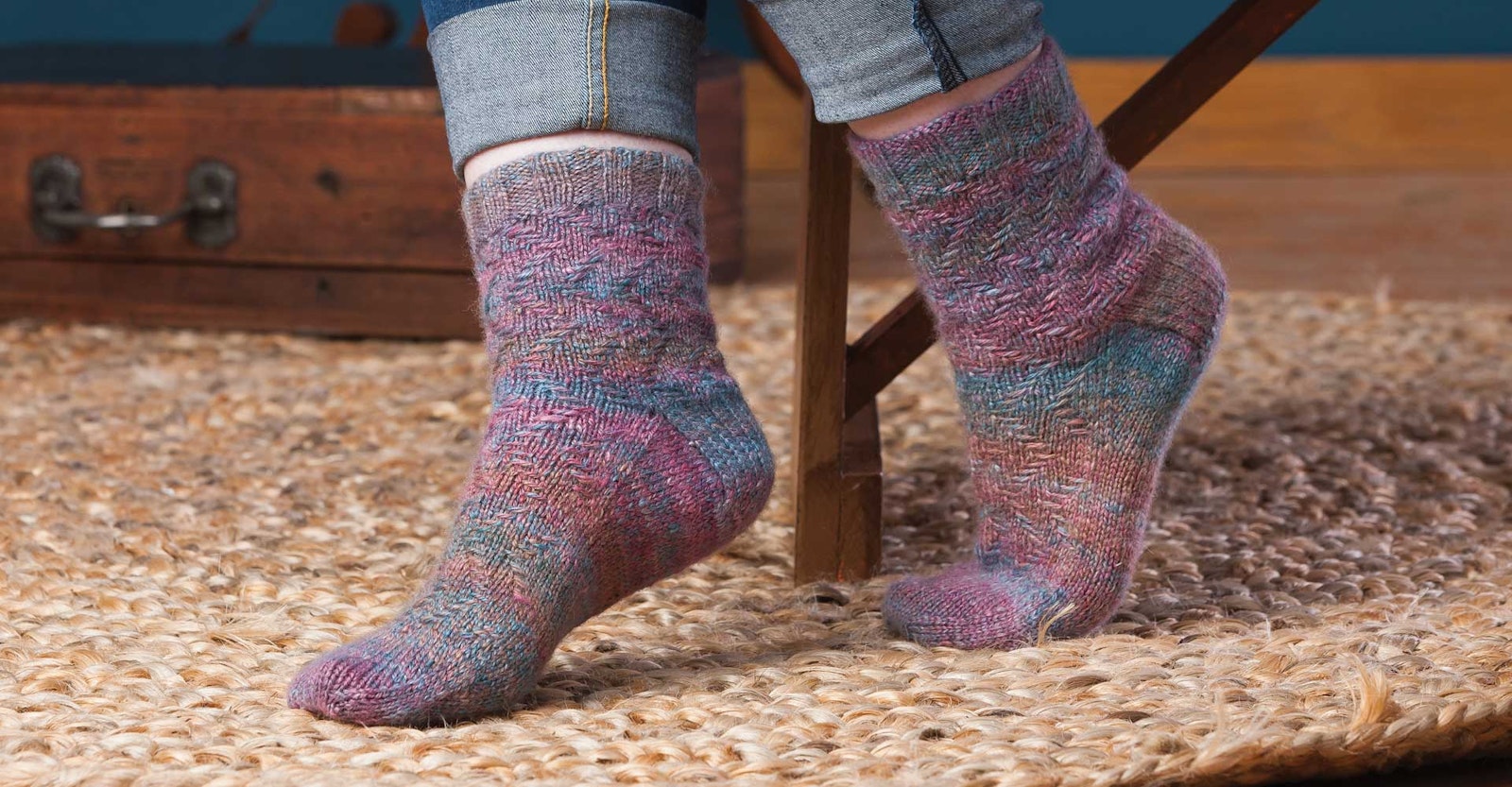https://spinoffmagazine.com/cdn-cgi/image/format=auto/https://www.datocms-assets.com/75073/1656683104-handspun-lida-rose-socks-1.jpg?auto=format&w=900
I love handspun handknitted socks. They are a lovely little treat to myself; I can pick a decadent fiber blend to use for the yarn and also have the enjoyment of spinning the fiber and knitting the yarn. A new pair of socks for the sock drawer is icing on the cake.
Spinning
I like BFL for socks as I find it wears nicely, and the addition of the silk also adds some wearability as well as a nice sheen to the finished yarn. I dyed this up in the “Wine Country” colorway, which is a blend of dark green, a dark walnut brown, a dark purple, and a burgundy red.
To spin the yarn, divide the 4-ounce braid of roving into three equal pieces and spin it as a three-ply fractal. I like three-ply yarns for socks, as I think this helps them wear longer. For the fractal striping, keep one of the thirds as is to spin end to end, creating long color runs on this set of singles. I did no other preparation to this third other than lightly fluffing the fiber. Split the second third of the roving lengthwise into four long strips. Split the final third of the roving lengthwise into eight very narrow long strips. Spin all of the singles with a short backward draft, smoothing the yarn to create a firm worsted-spun singles. Ply the three sets of singles, putting in plying twist equal to the spinning twist for a plied yarn that is just slightly overplied. Soak the skein in a lukewarm bath with wool wash until thoroughly saturated, spin out the excess water in the washing machine on a no-rinse cycle, give the skein a few snaps to even out the twist, and hang it to dry unweighted.
[PAYWALL]
Knitting
As my skein of handspun was slightly denser and thicker than the commercial yarn used for the original Lida Rose Socks design, I opted for the 60-stitch repeat size (after working a gauge swatch) for an 81⁄2" circumference finished sock. I used US size 0 (2 mm) double-pointed needles to knit my pair.
Materials
Fiber 4 oz Wooly Wonka Fibers 75% Bluefaced Leicester/25% silk top in wine country. Socks shown use 3½ oz of fiber.
Yarn 3-ply; 275 yd; 1,275 ypp; 20 wpi; sportweight.
Needles US size 0 (2 mm): set of 5 double-pointed (dpn). Adjust needle size if necessary to obtain the correct gauge.
Gauge 26 sts and 40 rows = 4" in St st; 28 sts and 40 rows = 4" in charted patt.
Notions Marker(s); tapestry needle.
Finished Size 8½" leg circumference and 9" from back of heel to tip of toe.
See Spin Off Abbreviations for terms you don’t know.
Notes
- To select the correct size sock, if your size falls between two sizes, choose the larger of the two since the fabric is slightly less stretchy than regular stockinette.
- Work a generous gauge swatch to determine how loosely/snugly to work the slipped stitches. The floats should lie flat on the surface of the stockinette, but should not be too loose or too tight. They should be loose enough to allow the stockinette to stretch to fit when the socks are pulled on, and not so tight that they cause puckering of the knitted fabric.
- The socks shown are knitted in the smallest size. The numbers in parentheses show stitch counts and directions for additional sizes, where applicable; see “Pattern Provenance” below for additional information.

Cuff
CO 60 (66, 72, 78, 84, 90) sts. Place marker (pm) and join in the rnd. Work in k3, p3 rib until piece measures 1½" (3.8 cm) from CO.
Leg
Rep Rows 1–20 of Lida Rose chart until piece measures 5½" (14 cm) from CO, ending with an odd-numbered row. Note next chart row to be worked.
Heel
Heel Flap
Set-up row Work 30 (33, 36, 39, 42, 45) sts in patt; heel is worked back and forth in rows over next 30 (33, 36, 39, 42, 45) sts.
Row 1 (RS) [Sl 1 pwise with yarn in back (wyb), k1] 15 (16, 18, 19, 21, 22) times, k0 (1, 0, 1, 0, 1), turn.
Row 2 (WS) Sl 1 pwise with yarn in front (wyf), p29 (32, 35, 38, 41, 44), turn.
Rep last 2 rows 14 (15, 17, 18, 20, 21) more times.
Turn Heel
Shape heel using short-rows as foll:
Short-row 1 (RS) Sl 1 pwise wyb, k16 (19, 20, 21, 22, 23), ssk, k1, turn.
Short-row 2 (WS) Sl 1 pwise wyf, p5 (8, 7, 6, 5, 4), p2tog, p1, turn.
Short-row 3 Sl 1 pwise wyb, knit to 1 st before gap, ssk, k1, turn.
Short-row 4 Sl 1 pwise wyf, purl to 1 st before gap, p2tog, p1, turn.
Rep last 2 short-rows 4 (4, 5, 6, 7, 8) more times—18 (21, 22, 23, 24, 25) heel sts rem.
Shape Gusset
Note: When working the first few and last few sts in charted patt on instep, if there are not enough sts to work a complete 3-st sl-st motif, work those sts in St st.
Next rnd Knit to end of heel, then pick up and knit 15 (16, 18, 19, 21, 22) sts along side of heel flap, pm, beg with chart row noted before heel, work 30 (33, 36, 39, 42, 45) instep sts in patt, pm, then pick up and knit 15 (16, 18, 19, 21, 22) sts along side of heel flap, k9 (10, 11, 11, 12, 12) sts of heel—78 (86, 94, 100, 108, 114) sts total: 48 (53, 58, 61, 66, 69) sole sts, 30 (33, 36, 39, 42, 45) instep sts.
Pm and join in the rnd.
Dec rnd Knit to 3 sts before m, k2tog, k1, sl m, work instep sts in patt, sl m, k1, ssk, knit to end—2 sts dec’d.
Next rnd Work even in patt.
Rep last 2 rnds 8 (9, 10, 10, 11, 11) more times—60 (66, 72, 78, 84, 90) sts rem: 30 (33, 36, 39, 42, 45) sts each for sole and instep.
Work even until foot measures 5½ (6½, 7, 8, 8½, 9)" (14 [16.5, 18, 20.5, 21.5, 23] cm) from back of heel, or 1½ (1¾, 2, 2, 2¼, 2½)" (3.8 [4.5, 5, 5, 5.5, 6.5] cm) less than desired finished length.
Toe
Rnd 1 *Knit to 3 sts before m, k2tog, k1, sl m, k1, ssk; rep from * once more, knit to end—4 sts dec’d.
Rnd 2 Knit.
Rep last 2 rnds 9 (10, 12, 13, 15, 16) more times—20 (22, 20, 22, 20, 22) sts rem. Knit to m; break yarn, leaving a 12" (30.5 cm) tail.

Finishing
With tail threaded on a tapestry needle, use Kitchener st to graft sts tog. Weave in ends. Soak in lukewarm bath, then gently press or spin excess water out. Lay flat to block, patting sl-st patt straight, but do not overly stretch fabric. Allow to dry thoroughly.
Pattern Provenance
Anne originally created this pattern with commercial yarn and published it in Sockupied Fall 2014. Work a generous gauge swatch with your chosen yarn to help you choose an appropriate stitch count if your handspun is a different grist than the commercial yarn, as Anne’s was. The following description is from the original pattern:
These socks feature an easy zigzag slip-stitch pattern. Worked in variegated yarns, this patterning helps break up the color pooling, and when used with a more subtle or subdued solid yarn, yields a simple undulating pattern on the leg and down onto the foot—perfect for anyone deserving of handknitted socks.
Yarn Shibui Knits Sock (100% superwash Merino wool; 191 yd [175 m]/1¾ oz [50 g]), 2 (2, 3, 3, 3, 3) skeins.
Needles U.S. size 1 (2.25 mm). Adjust needle size if necessary to obtain the correct gauge.
Notions Marker(s); tapestry needle.
Finished Size 6¾ (7½, 8¼, 9, 9½, 10¼)" (17 [19, 21, 23, 24, 26] cm) foot circumference and 7 (8¼, 9, 10, 10¾, 11½)" (18 [21, 23, 25.5, 27.5, 29] cm) long from back of heel to tip of toe; foot length is adjustable.
Gauge 36 sts and 73 rnds = 4" (10 cm) in charted patt.

Anne Podlesak is the owner and dyer at Wooly Wonka Fibers. She knits, spins, and dyes in her studio in the mountains in northern New Mexico. Her designs have been featured in Spin Off magazine, Jane Austen Knits, Twist Collective, and The Unofficial Harry Potter Knits. She is the author of the recently released Free Spirit Knits from Interweave.
Resources
Wooly Wonka Fiber, www.woolywonkafiber.com
this project was originally published in the Winter 2016 issue of Spin Off.




